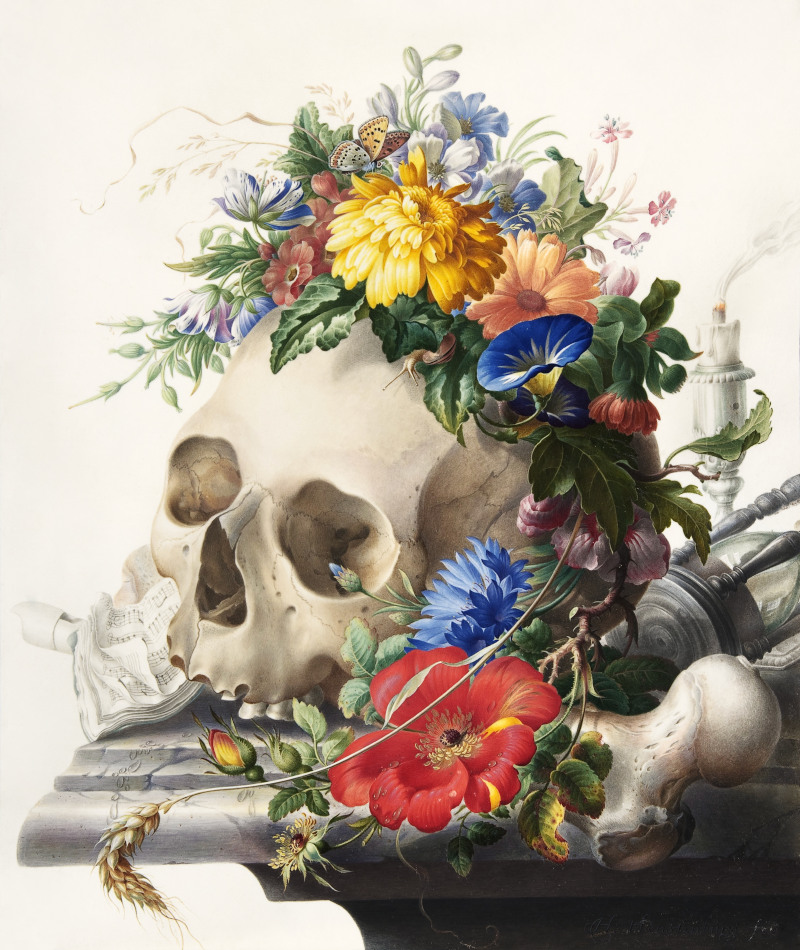Skulls within paintings and sculptures have been used by many famous artists over the centuries, for a variety of purposes. Here we examine the most famous skull artworks.
Introduction to Skull Paintings and Sculptures
Skulls carry significant symbolism which artists have been tapping into for centuries, though in some cases their usage has more been about aesthetic display. Some have used them to represent dark emotions and meanings, such as death, mortality, and the macabre, and their use has also varied across cultures, who each treat death in different ways, with either a spirit of celebration or of commiseration and sadness. One example of that would be the Day of the Dead in Mexican culture.
Skulls have appeared in still life art, such as in the Netherlands, and were popular additions at that time. They have also been used as carved elements in sculpture, or in a variety of guises acros the 20th century when mixed media was at its most prevalent. The inherently strong meanings represented by skulls have encouraged their use in art, with many using them in social and political commentary, such as discussing our relationship with death itself.
The music industry also regularly incorporates them into art, including album covers, clothing decoration and more, which is most commonly found in the Rock genre. This has been the case for decades, and some followers of this music might add some of the skull paintings seen below as art for their own homes, or alternatively select skull jewelry which is also widespread. Whatever the century or decade, humans continue to grapple with the meaning of life, and therefore also have a mixed relationship with the meaning and reality of death itself, with skulls in art being used to represent that.
List of Famous Skull Artists
We have selected some famous skull paintings and sculptures from major artists dating back centuries, and list them below. You will discover the wide range in which this item has been used, both in a positive and negative manner, and with multiple meanings. There is also a contrast between our relationship with death in religious and non-religious societies, where faith can help in some ways to dampen the fears of the unknown, though this varies across cultures.
Each skull artwork is accompanied by a summary of the artist's career, style and also a description of the artwork itself. These contributions date back as far as the Renaissance era in the 15th century, all the way up to the 20th century, with an exciting artistic variation between all of these featured in this list. You will also notice the range of symbolic values represented by skulls across these different interpretations.
Vanitas Still Life by Herman Henstenburgh
Herman Henstenburgh was a significant 18th century Dutch artist who embraced still life art with imagination and high technical skill. His focus on flowers brought bright color into his paintings, and in some cases he would combine them with skulls, bringing symbolism into the composition. Vanitas is a term commonly found in Dutch art in which still life symbolism was used and skulls were one of the elements used over and over again.
The brilliance of the painting below is in the detail, and the expressive combination of items which was clearly curated, but still works fluidly. The artist was also a skilled copyist and sketcher of insects, and was therefore highly skilled as a technical artist in order to achieve this level of accuracy within his work. He remains famous as a skull artist for the painting below, which is perhaps his best known work of all.
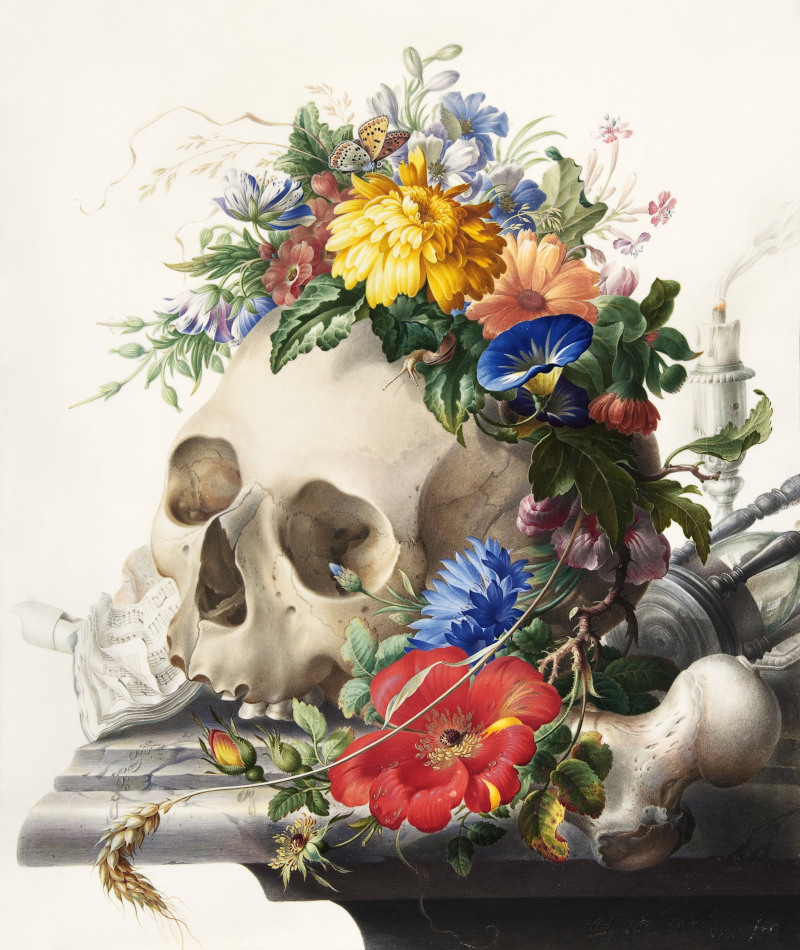 Vanitas Still Life by Herman Henstenburgh
Vanitas Still Life by Herman Henstenburgh
Memento Mori by Julie de Graag
Memento Mori is one of the most impactful skull posters and was produced by Julie de Graag, a Dutch watercolorist, printmaker and oil painter. She was in the Royal Academy of Fine Arts in The Hague, and is classified under the Art Nouveau movement. Her work was minimalist in style, many years before the rise of Abstractionism, marking a ground-breaking approach which was well ahead of its time. Her paintings struggled for exposure for years, but today her oeuvre is highly regarded and Memento Mori remains one of the most famous skull posters to date.
The beaty of this artwork is in how the artist reduces the detail down, in order to replicate the skull in just two colors - black and white. There is no tonal variations, giving this piece the style of an illustration of the 20th century. It wa s produced as early as 1916, when such an approach was almost unheard of and it is entirely appropriate that the artist has now achieved significant success, although it took many years after her death before that was the case.
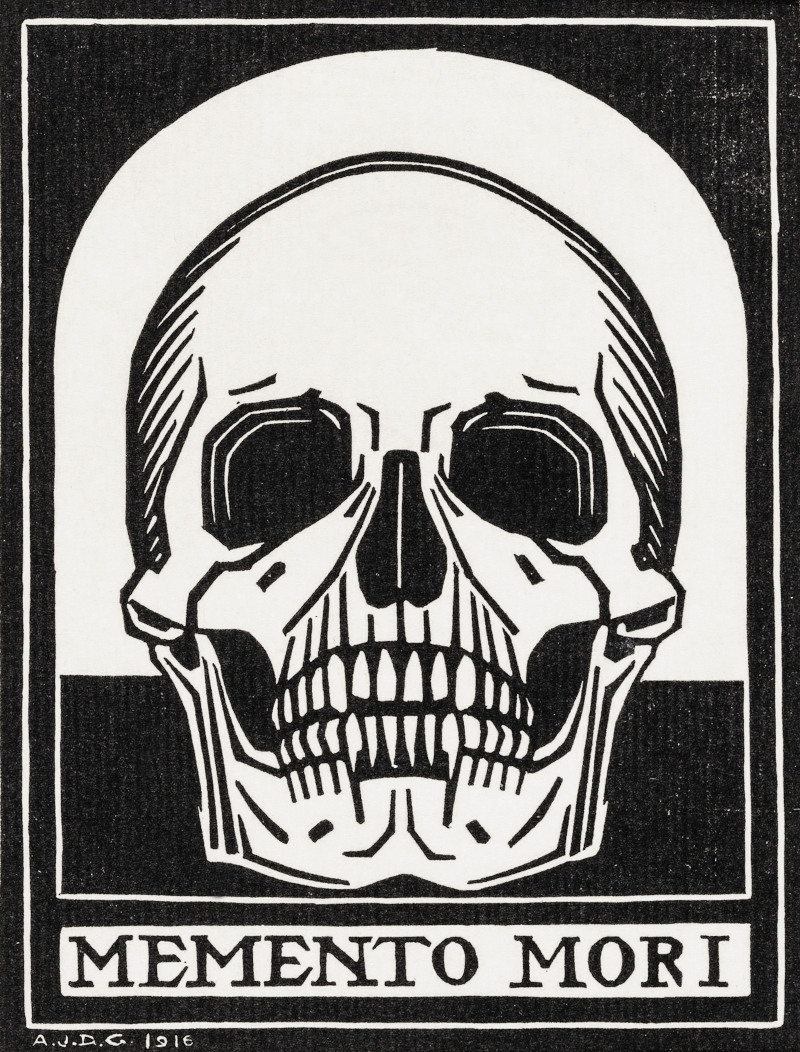 Memento Mori by Julie de Graag
Memento Mori by Julie de Graag
Ram's Head Blue Morning Glory by Georgia O'Keeffe
Georgia O'Keeffe is remembered for her use of animal bones which she found lying around the New Mexico landscape. She created inventive, modern still life artworks which felt like a refresh of those found in the Dutch Golden Age, but with the color and light found across the stunning region of the US. The use of animal bones instead of human skulls gives an entirely different balance and meaning to the work, perhaps with a more positive outlook.
When viewing human skulls, one might reflect on their own mortality, but with the ram featured in the painting below, there is not the same feeling. Instead, we see it more in an aesthetic manner, with the artist able to reflect light around the contours of the skull, and add other items around it. O'Keeffe loved to use flowers in her work as well, as in this artwork she combines the two in an unusual manner, representing the best of American Modernism.
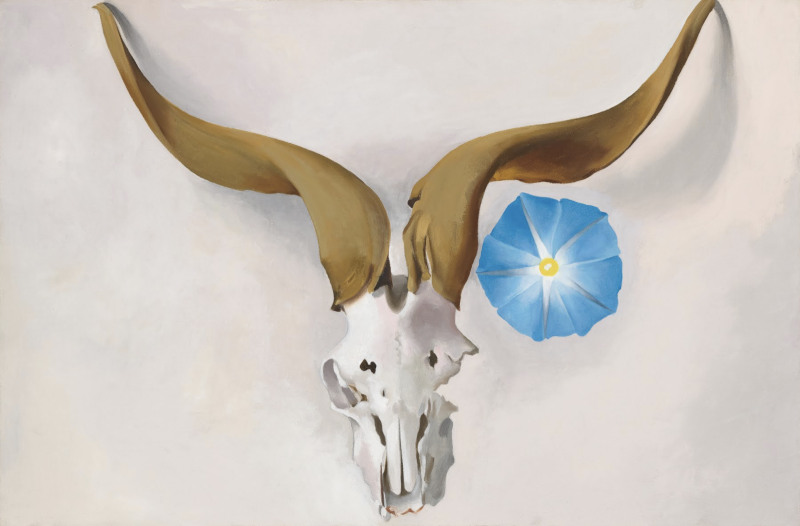 Ram's Head Blue Morning Glory by Georgia O'Keeffe
Ram's Head Blue Morning Glory by Georgia O'Keeffe
Death and Life by Gustav Klimt
This powerful work by Austrian Secessionist, Gustav Klimt, separated the composition into Life and Death, with a skeleton on the left representing the latter. We see the skull emerge from the dark background, and two skeleton hands hold a weapon in a menacing manner. His outfit stretches to the bottom of the painting, and features a pattern of crosses in white and black, along a blue strip of material. He looks across at the life section, which contrasts considerably with a brighter set of tones, and more positive atmosphere.
Symbolism became a key element of Vienna art during this period, though Klimt would not always use it within his work. In other examples he depicted landscape scenes just as they were, allowing the beauty of the location to speak for itself. He was a true master of figurative art, as found in his classic, The Kiss. Symbolism continued in Tree of Life, which had been used for centuries by a variety of artists to represent life and health. Klimt remains one of the most famous skull artists thanks to the success of Life and Death.
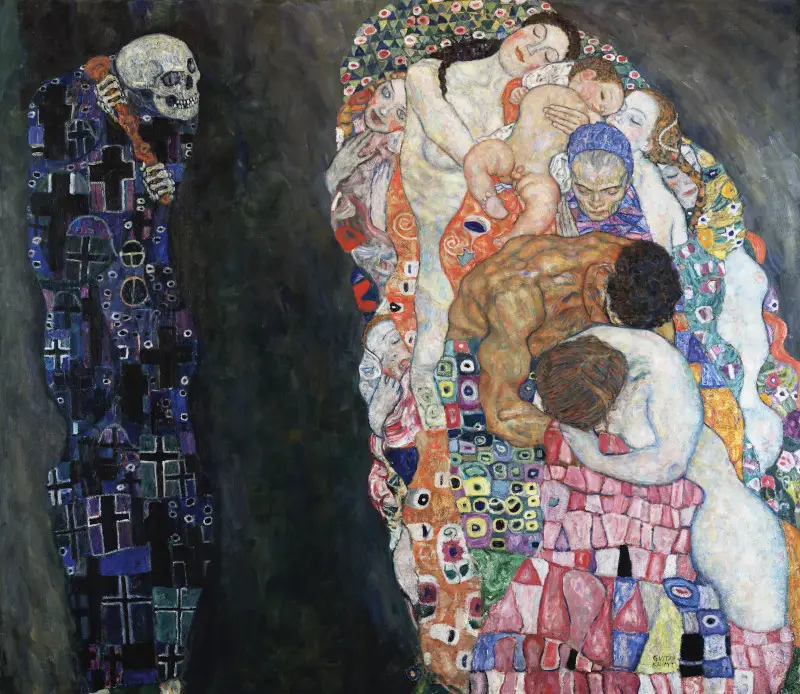 Death and Life by Gustav Klimt
Death and Life by Gustav Klimt
Head of a Skeleton with a Burning Cigarette by Vincent van Gogh
Head of a Skeleton with a Burning Cigarette is the most famous skull painting in history - the combination of a skull with cigarette was original, and underlines the expressive nature of the artist. It has achieved a cult like status, just as Van Gogh has himself. There is also a contemporary quality to this work, even over a century after it was produced. Van Gogh used bold, long brushstrokes and dramatic lighting for this painting, with the skeleton contrasting against the dark, plain background.
Darkness fall across the eye sockets, bringing a sinister image in which death continues to live. Van Gogh himself had a turbulent mental balance which would have brought such themes into his mind and he struggled throughout his life. Even regular treatment was unable to curb these problems which would ultimately lead to his passing, indirectly. These emotions also inspired his work, though, and that brings a positive aspect to his difficult life.
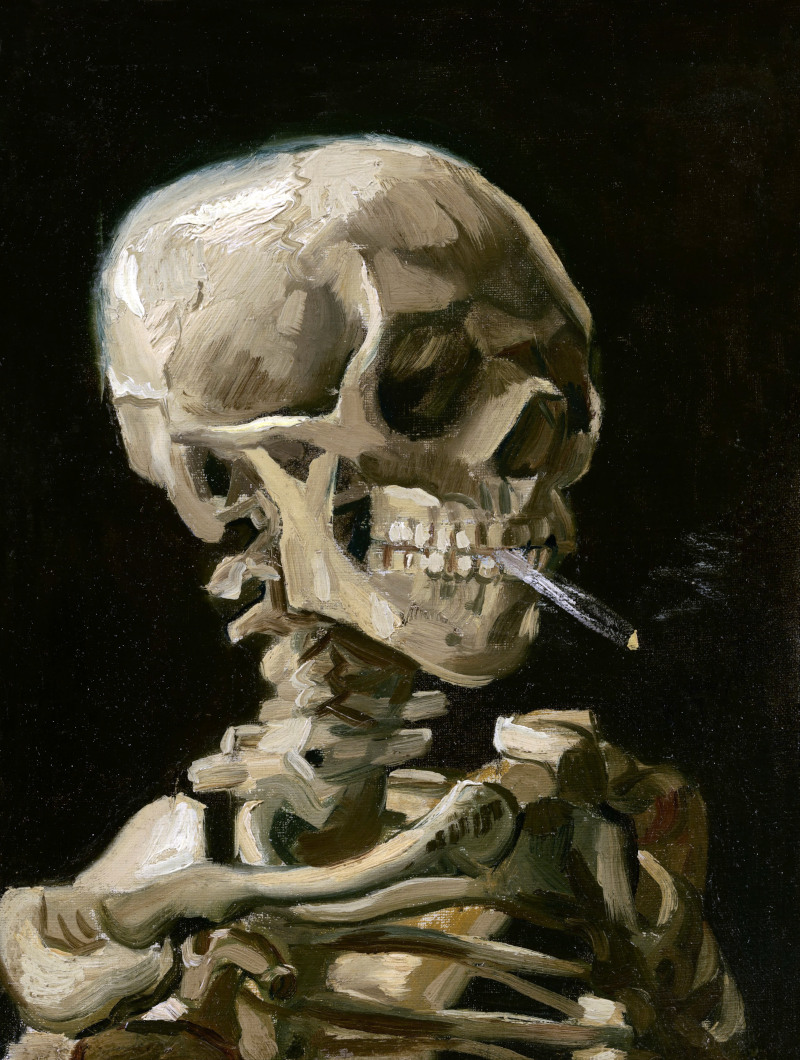 Head of a Skeleton with a Burning Cigarette by Vincent van Gogh
Head of a Skeleton with a Burning Cigarette by Vincent van Gogh
Vanitas Still Life by Jan van Kessel
Jan van Kessel the Elder was a highly skilled Antwerp artist who covered genre scenes and still life artworks within his career. Much of his content was typical of the region, and in the example below we find the Vanitas art which was typical of North European art from the 17th century. Skulls were one of the symbols of iconography that were regularly used, and in this painting we find a series of flowers intertwined around the skull. Bubbles float down from above, whilst a butterfly rests to the side, with life and death represented together in the same piece.
Jan van Kessel also produced a number of maritime artworks, and insect depictions, and was generally regarded in style as typical of the era. His detailed artworks could be reproduced as prints and sold elsewhere in Europe, where as his landscape scenes were individual items that could command higher prices as unique pieces, but would have taken longer to put together.
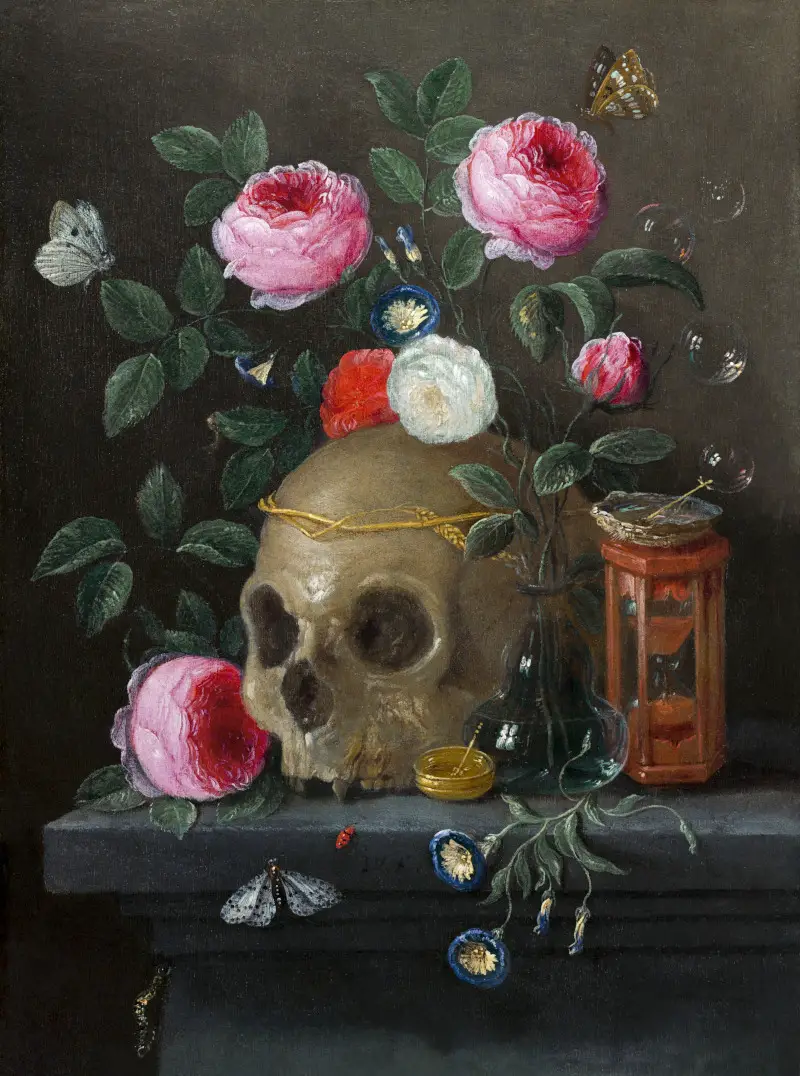 Vanitas Still Life by Jan van Kessel
Vanitas Still Life by Jan van Kessel
Calaveras Oaxaquena by Jose Guadalupe Posada
Jose Guadalupe Posada was a skilled illustrator who produced lithographs, such as this one shown below. Works such as the one shown below, as well as La Calavera Catrina, made use of skulls and skeletons and became a hallmark of his work. This Mexican sketcher formed an impressive body of work in the late 19th and early 20th century, and he also represents the popular use of skulls within Mexican art, partly due to its more positive relationship with death, as compared to western societies. He eventually worked as a teacher, where he was able to influence later generations of artists.
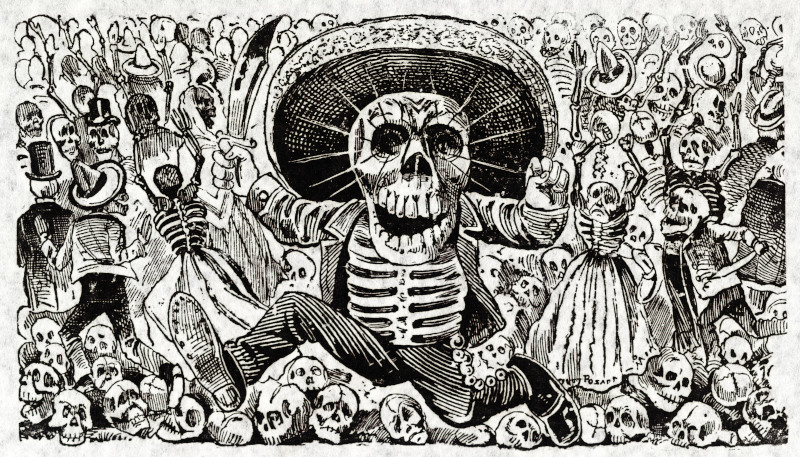 Calaveras Oaxaquena by Jose Guadalupe Posada
Calaveras Oaxaquena by Jose Guadalupe Posada
Still Life with Skull by Paul Cezanne
Paul Cezanne was a master of still life art, and was able to work alone by focusing on this genre, alongside his many landscape paintings from within the French countryside. In this still life he refers to the method of Dutch art, incorporating a skull into the work, placing it on a table, alongside a variety of fruit, with a table cloth wrapped over loosely, revealing elements of the table below. The piece was titled Still Life with Skull, because he would not usually make use of skulls, and normally just relied on fruit.
As his career developed, Cezanne became more expressive and slowly transitioned towards Cubism, or at least laid the foundations for its exponents to succeed shortly after the turn of the century. Even his still life artworks would start to be reduced to fractals of color, with angles experimented with as the gap between painting and sculpture started to narrow. He remains regarded as the father of modern art, because of the ideas that he brought into European art.
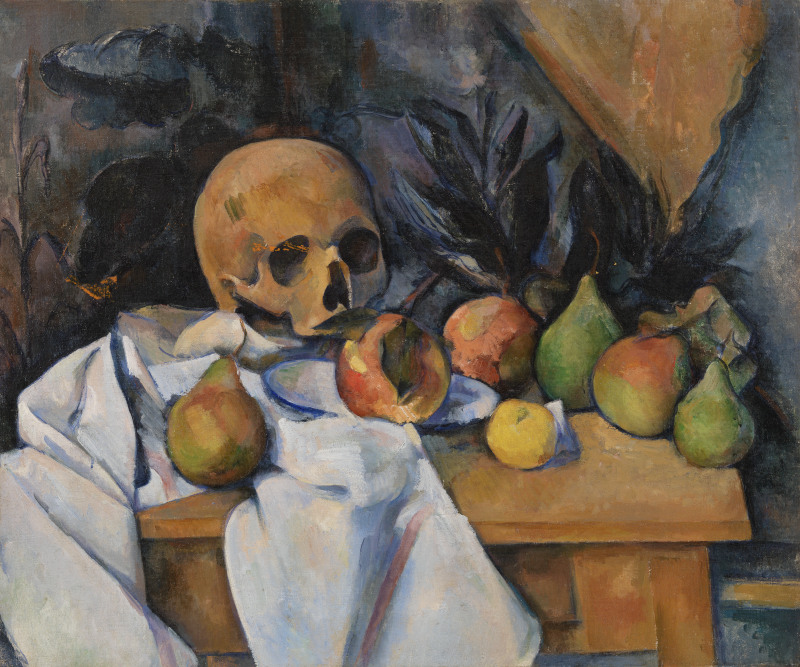 Still Life with Skull by Paul Cezanne
Still Life with Skull by Paul Cezanne
Young Man with a Skull by Frans Hals
Frans Hals was a delightful artist who created enjoyable depictions of ordinary folk in the Netherlands. In this interpretation he decided to include a skull for symbolic value alongside the main portrait. He created scenes of life in public houses, where the local characters would show themselves, and the enjoyable side of life would appear. Many of his portrait subjects were anonymous, and captured in a moment of fun which would last for centuries through his paintings.
One of Hals' biggest qualities as an artist was his attention to detail in his work, which included accurate representations of clothing and facial expressions. He also had an expressive use of brushwork, creating emotion within his portraits which helped to get across the scene to the viewer. Compare that to the likes of Ingres and Bronzino who were also technically skilled, but sometimes lacked the same energy within their work.
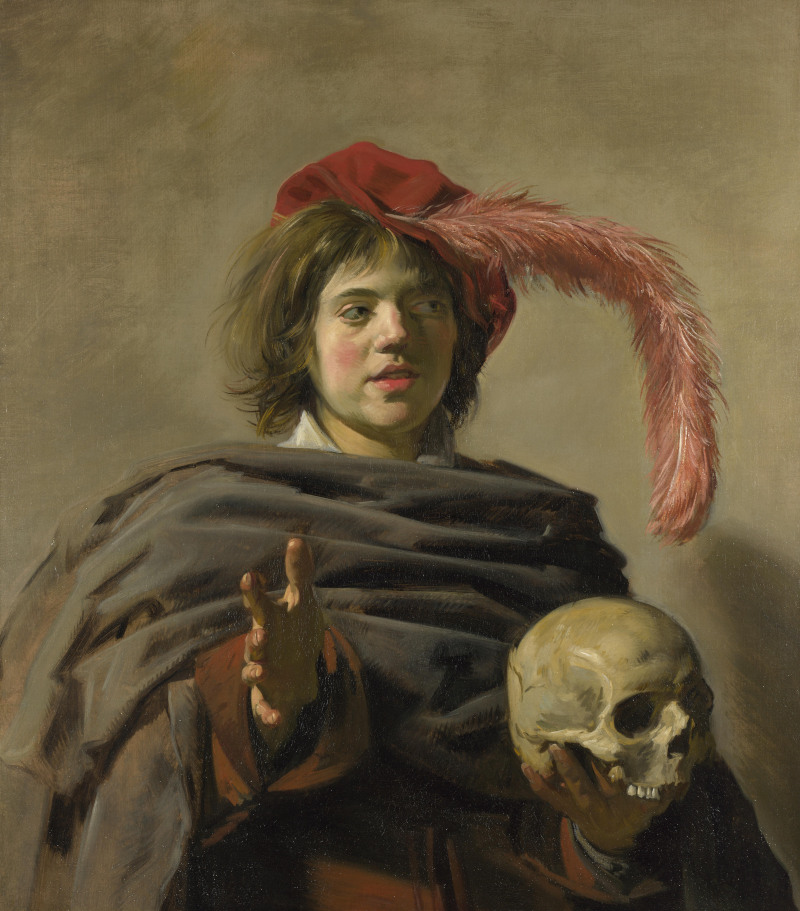 Young Man with a Skull by Frans Hals
Young Man with a Skull by Frans Hals
Skull in Profile Etching by Wenceslaus Hollar (After Leonardo da Vinci)
Leonardo da Vinci was a true master of anatomy and the item below was an etching produced directly from one of his famous skull drawings. He loved to study and observe the human body in an attempt to understand its intricate variations. His drawings achieved unrivalled accuracy because of his attention to detail and obsessive approach to precision. Wenceslaus Hollar will have recognised his brilliance and therefore chosen to reproduce the drawing as an etching, allowing many prints to be produced and sold. Da Vinci's best work was studied for centuries after his passing.
The drawing features a skull resting on a book in order to keep it level. The skull is angled off to our right, losing many of the symbolic qualities that other artists would utilise. Instead, this artwork is all about study and accuracy, aiming to replicate reality as closely as possible which was common from the 15th to 17th century. It was only later that European art started to become more expressive, where artists would bring their own emotions into each artwork.
.jpg) Skull in Profile Etching by Wenceslaus Hollar (After Leonardo da Vinci)
Skull in Profile Etching by Wenceslaus Hollar (After Leonardo da Vinci)
Still Life with a Skull and a Writing Quill by Pieter Claesz
Pieter Claesz was a Dutch Golden Age artist who specialised in still life art, and was highly skilled in his technical work. His use of light and reflection, as well as the detail and accuracy of his paintings was extraordinary, but he was not able to achieve the same success as the leading lights of this era. He remains a respected, fringe figure, whose qualities are demonstrated here in a work titled, Still Life with a Skull and a Writing Quill. Most of his paintings were complex arrangements of still life scenes, as found here and normally objects would be placed on a table.
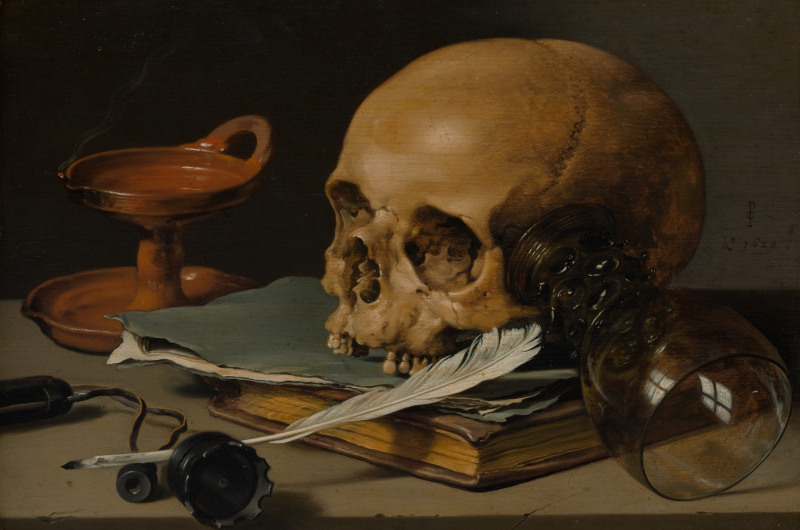 Still Life with a Skull and a Writing Quill by Pieter Claesz
Still Life with a Skull and a Writing Quill by Pieter Claesz
Saint Jerome Writing by Caravaggio
Saint Jerome Writing displays this significant figure hard at work, sat besides his desk. A skull is placed at the far side, perched on a number of open books, with light shining directly down upon it, lighting up the cranium. The eyes are darkened, allowing us to appreciate the contours of its structure. The saint is given a halo, helping us to identify him alongside the other clues in this composition, and his considerable beard suggests age and wisdom. The artist would produce two versions of this content, in 1605 and again in 1607.
Caravaggio paid close attention to the material surfaces and textures in this painting too, and represents the twists of material through a careful handling of light which was at the centre of Baroque art, and particularly the Caravaggisti style. Few artists achieved such levels of drama and excitement as Caravaggio, and his use of the skull displayed a consideration of content besides merely the surface level details.
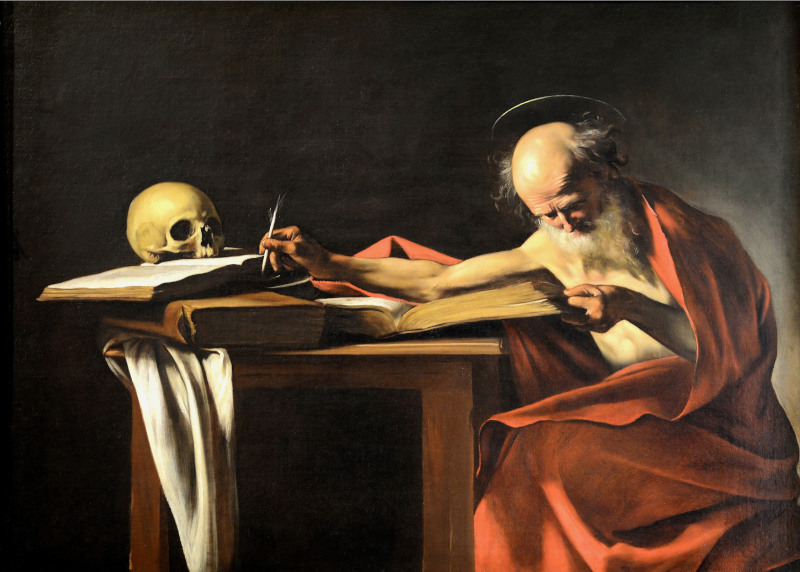 Saint Jerome Writing by Caravaggio
Saint Jerome Writing by Caravaggio
Saint Francis by Francisco de Zurbaran
Francisco de Zurbaran used dramatic lighting in most of his work, which led to many comparing him to the great Italian master, Caravaggio. He worked mainly on religious scenes, with some still life work, and within this piece there is a combination of the two, with an impressive display of Spanish Baroque painting techniques. Zurbaran's painting was later taken on by Dali in the 20th century, who created his own tribute in an entirely modern style.
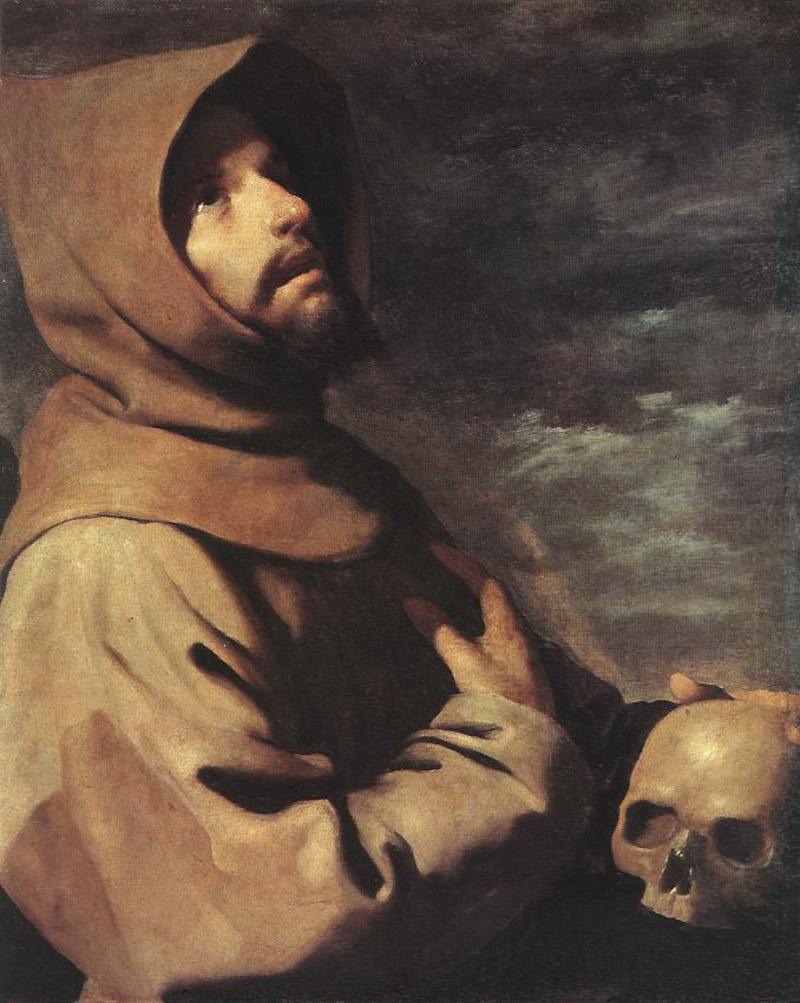 Saint Francis by Francisco de Zurbaran
Saint Francis by Francisco de Zurbaran



